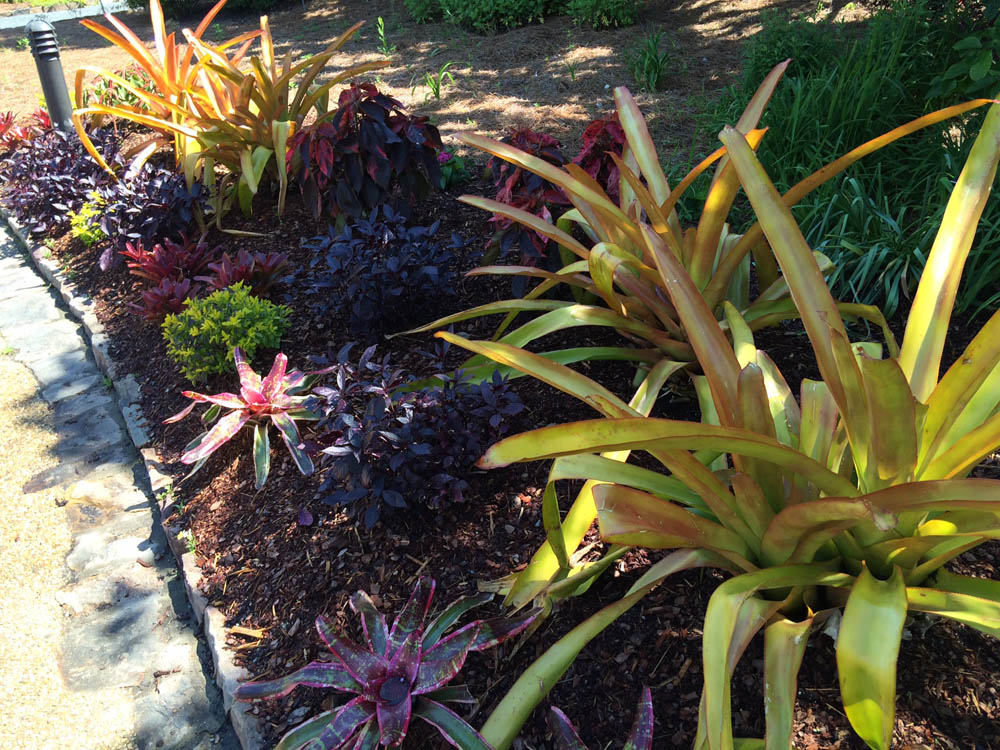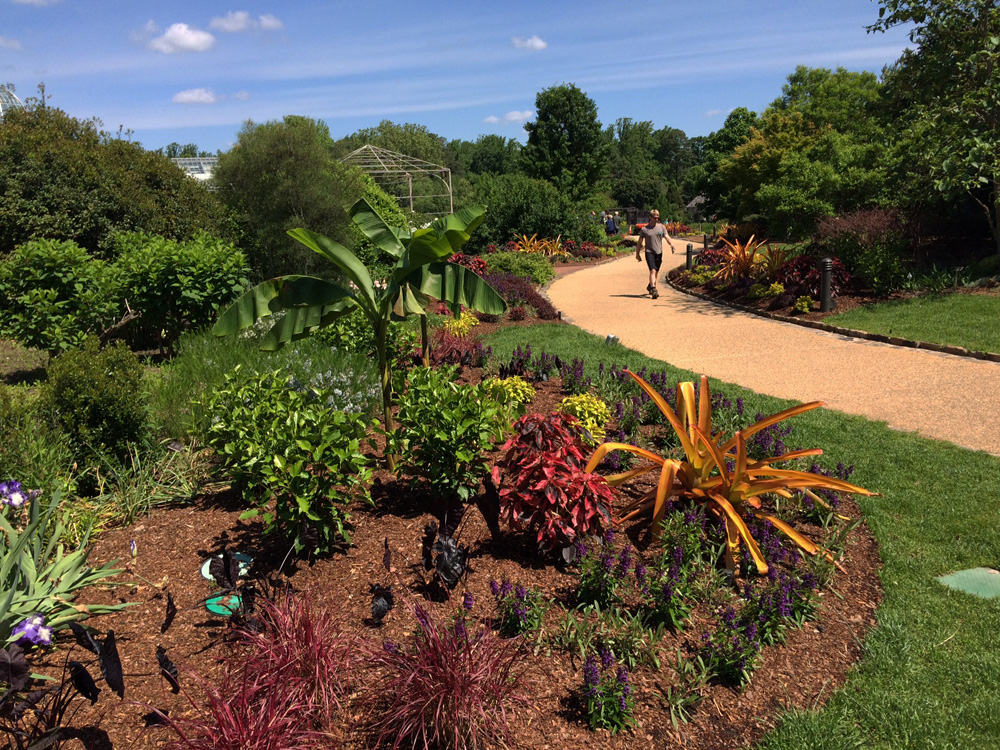A Bed is Born
A Behind-the-Scenes Look at Garden Design
Give a gardener a new bed, full of fresh soil and unlimited possibility, and stand back. Twice a year at Lewis Ginter Botanical Garden, in early spring and again in early fall, horticulture staff and volunteers pull spent bulbs and weary annuals out of their beds and replace them with a flourish of fresh new plants. We call it “bedding change-out,” but its more like changing the sheets. And then, just as Mother Nature reinvents herself with each cycle of the seasons, the Garden is transformed. Visitors are treated to an evolving landscape and a chance to discover new inspiration for their own garden design. Little do they know that plans for the new display began last spring.
Senior Horticulturist Shannon Smith designed the beds along the Main Garden Walk, which winds from the Visitors Center to the Cochrane Rose Garden. She worked in collaboration with Horticulturist Leah Purdy who chose the high contrast color palette, the tropical theme and some of the base plants for this year’s walkway. And although the creative process is as unique as the creator herself, Smith’s approach to garden design involves the same elements that every designer considers.
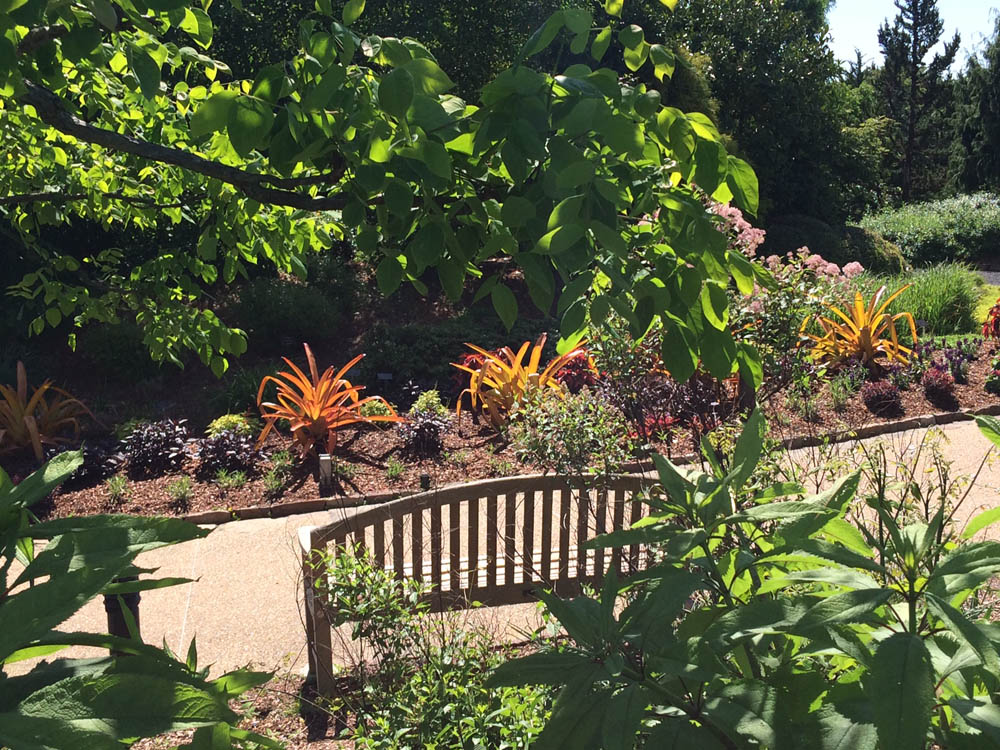
The Main Garden Walk winds through the Central Garden from the Robins Visitor Center to the Louise Cochrane Rose Garden, with plenty of places along the way to stop and admire its artistry.
Smith begins with her least favorite part: the math. The square footage of the bed is calculated using a set of formulas that work out the dimensions of odd-shaped spaces. This brief decent into spatial logic will help her calculate the number of plants required when it comes time to order. Then she begins setting parameters for herself, narrowing the possibilities so that she can hone in on a plan that resonates.
Look and feel come first. Does the bed want to be loose, light and flowing or more classical and structured? Symmetrical or asymmetrical? Bold or delicate? Next she narrows her color palette, choosing temperature (warm or cool,) and value (light or dark) or maybe something monotone. When she is making decisions at this level, Smith holds in the back of her mind the visual play between the new bed and its neighboring beds. Her goal is to distinguish each of the individual gardens from one another (so that the visitor knows they have entered a new space as they walk along,) while preserving the harmony of the Garden as a whole. “I’m spinning a thread that draws the eye down the walk,” she says, “creating movement in a static space.”
Then she looks for inspiration. She browses through plant catalogs, of course. But she is more likely to find her muse in a fabric swatch or a favorite painting. Sometimes she takes direction from plants themselves, referencing the deep red in the center of a blossom or the tip of a chartreuse leaf. “Four years ago, I remember borrowing colors from an outfit in a J. Crew catalog for the palette in a new bed,” she says. “After the installation, I walked by the bed one day and discovered a group of VCU [Virginia Commonwealth University] Fashion Design students who were visiting the Garden for inspiration. They were taking notes, allowing the colors in the bed inform their clothing design.”
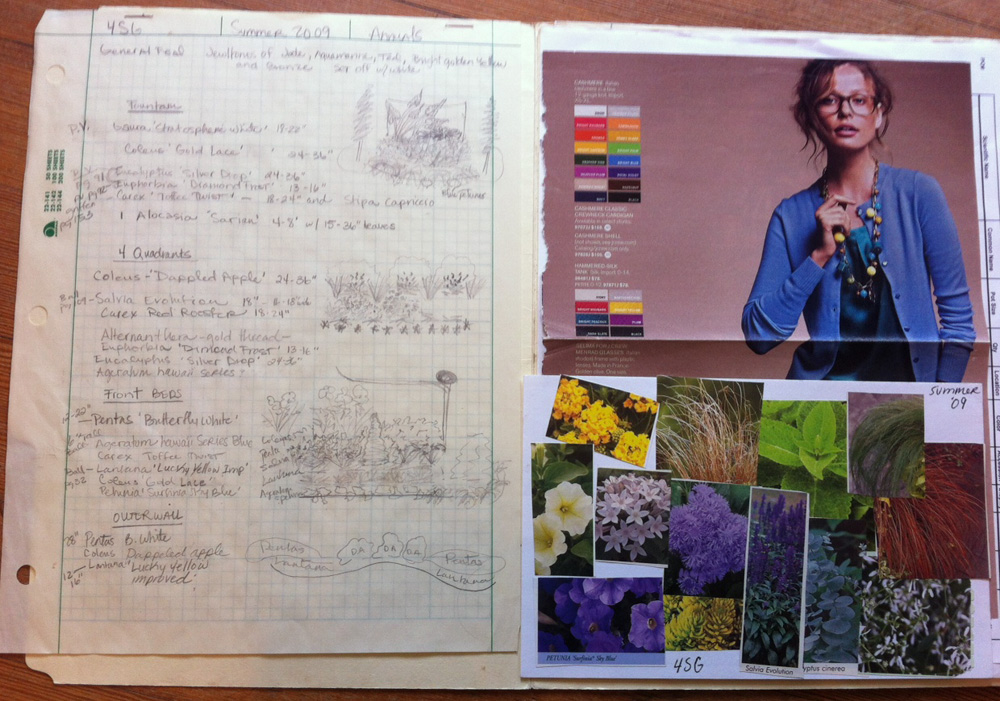
A mood board helps organize Shannon Smith’s color choices. Her preliminary plant list and sketches echo those decisions. This example is from a past year.
Smith’s horticulture skills come into play next as she picks specific plants for the bed. She considers soil composition, sun or shade requirements, form, size and growth habit, hardiness, texture and whether a plant will require constant maintenance. Smith has been known to make 5 x 8 inch flashcards for herself at this stage, using photos of each of the plants that she has in mind. Moving the cards around helps her to visualize how the individual plants will play off of each other and function as part of the whole. She makes careful notes for the horticulturist who will be responsible for caring for the bed, clarifying her original vision and giving guidance for grooming or replacement when a plant blooms out.
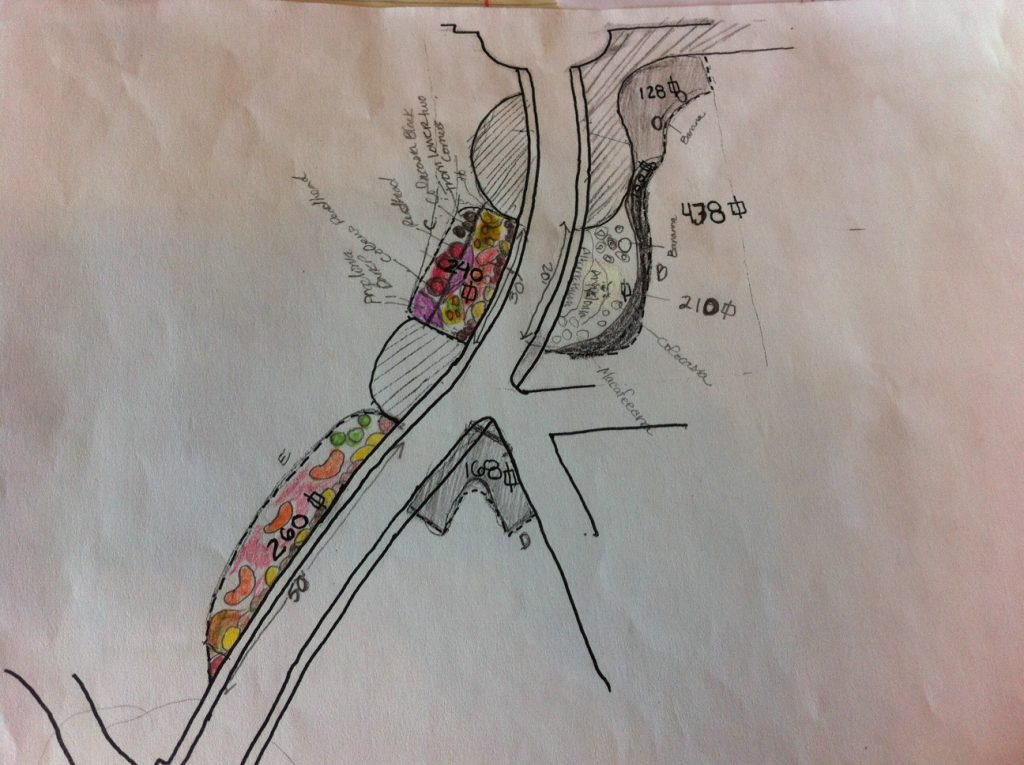
Swaths of color, each representing a group of plants in the bedding plan, come together in a bright mosaic. This is a past year’s design.
A bedding plan, drawn to scale on graph paper in colored pencil, follows. The plan is at once a detailed schematic and an impressionist painting, where each plant is represented by a different color. Smith weaves her hues into a layout, applying broad strokes or tiny spots of color to symbolize a grouping or a single specimen plant. Initially she locates three to five focus plants, and then, keeping the other plants’ attributes in mind and considering how they relate to each other, fills in where she needs vertical emphasis or ground cover, for example. What began as a two-dimensional drawing grows into three dimensions, rising to its full potential.
Finally, there is peer review, a meeting where she presents concepts to horticulture and Garden staff. Feedback is offered, plans for the new garden design are tweaked and then final approval from Director of Horticulture Grace Chapman Elton is secured. The design phase complete, quantities are calculated and plants ordered. Then the installation begins. Four horticulturists and a small group of volunteers worked alongside Smith for two days on the Main Garden Walk this year, installing the plan she developed. They set pots in place as basic framework, first the primary plants, and then secondary elements, following her drawings but keeping the framework flexible to allow for substitutions and inspiration on the fly.
For Smith, most of the garden design process is intuitive. She laughed when asked to describe her approach.”This is the most I ever thought about it,” she replied.
Every year, 10 different annual beds at Lewis Ginter Botanical Garden are re-designed by our gifted team of 15 horticulturists and a number of dedicated volunteers. Shannon Smith’s process is but one example of the time and talent that goes into recreating this remarkable place season after season.
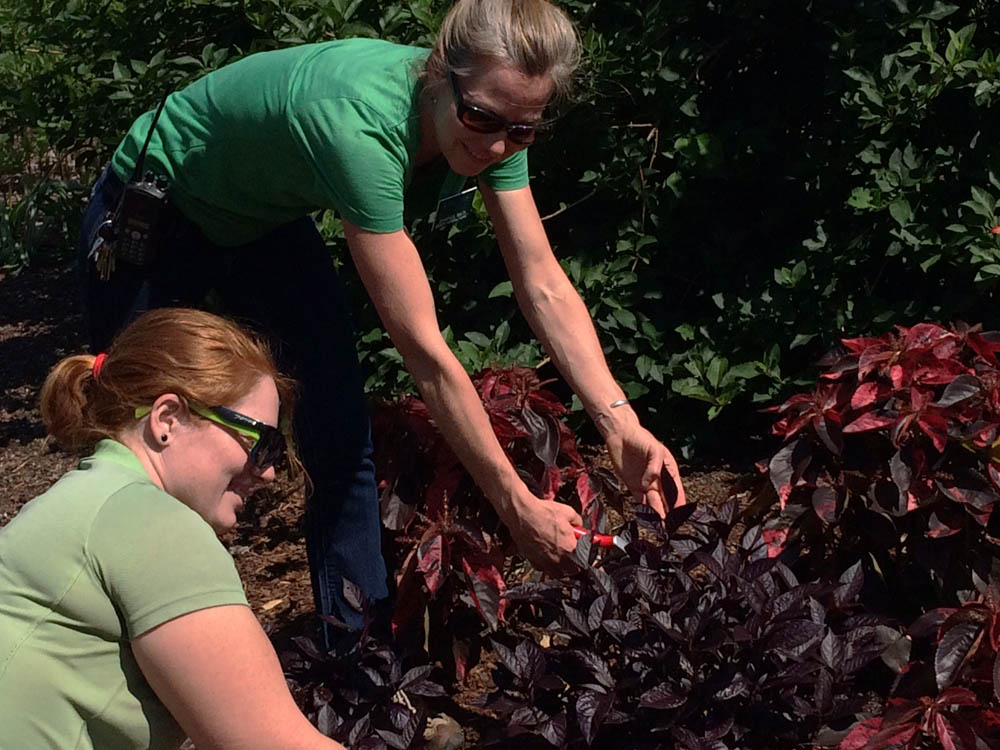
Shannon Smith (r.) and Leah Purdy (l.) groom plants in the Main Garden Walk, keeping their collaborative creation at its peak. Senior Horticulturist Shannon Smith designed the Main Garden Walk for the second time in 2016 after designing the annual beds in the Central Garden since 2005.
The plant list for the 2016 Main Garden Walk bed design:
| Common Name | Scientific Name | Cultivar |
| Copperleaf | Acalypha wilesiana | ‘Musaica’ |
| Chenille Plant | Acalypha hispida | none |
| Joseph’s Coat | Alternanthera | ‘Red Carpet’ |
| Joseph’s Coat | Alternanthera | ‘Red Marble’ |
| Blanchettiana Bromeliad | Aechmea blanchettiana | none |
| Black Coral Taro | Colocasia esculenta | ‘Electric Blue Gecko’ |
| Elana Taro | Colocasia esculenta | ‘Maui Gold’ |
| Hibiscus | Hibiscus rosa-sinensis | ‘Edward La Plante’ |
| Maria Bromeliad | Neoregelia | ‘Margaret’ |
| Super Fireball Bromeliad | Neoregelia | ‘Super Fireball’ |
| Red Head Coleus | Solenostemon scuttelarioides | ‘Red head’ |
| Star Cluster | Penta lanceolata | ‘Butterfly Deep Pink’ |
| Summer Snapdragon | Angelonia angustifolia | ‘Dark Purple’ |
| Japanese Banana | Musa | ‘Basjoo’ |
| Sage | Salvia splendens | ‘Lighthouse Purple’ |
| Angelonia | Angelonia angustifolia | ‘Dark Purple’ |
| Coleus | Solenostemon scutellarioides | none |
| Pineapple Sage | Salvia elegans | ‘Golden Delicious’ |
| Fountain Grass | Pennisetum setaceum | ‘Rubrum’ |
| Button Flower | Gomphrena haageana | ‘Red’ |
